Abstract
Agricultural production in the Atacama Desert is restricted by extreme aridity and poor soil quality. Between 18° S and 30° S, low stratocumulus clouds regularly cover the southeastern Pacific Ocean reaching the Coastal Cordillera. Thus, marine fog is constantly present in the coastal areas of the desert. Fog can be harvested using fog collectors. However, limited information is available with regards to the variability of fog presence throughout the year and along the coast of the desert. Combining fog water harvest with hydroponic production under greenhouse facilities presents an alternative for sustainable and local fresh food production. In this article, we analyze the potential of fog water collection in two sites (Alto Patache and Falda Verde) distant by about 1000 km within the Atacama Desert. Additionally, in both locations, the environmental conditions within greenhouse structures, the potential energy requirement for environmental conditioning (including the energy production from photovoltaic panels) and the water requirements of vegetable crops under greenhouse conditions were modeled. The annual average of fog water collection registered was 2.9 and 3.3 L per day per m2 in Alto Patache and Falda Verde, respectively. During the most demanding season for crop evapotranspiration, 2.13 m2 of fog collectors can supply the water required for 1 m2 of greenhouse crops. The energy required for water and air pumps in the hydroponic systems can be supplied with photovoltaic systems including eight PV modules and a battery storage capacity of 9.4 kWh. In conclusion, the present study sheds light on the possibilities of massive water collection from fog to be used in local and sustainable food production in the Atacama Desert.
1. Introduction
The Atacama Desert is located in northern Chile, between 18° S and 30° S. It is known as one of the most arid territories on the planet, ranging from hyper- to semi-arid environments [1]. Mean annual precipitation is as low as 0.8 mm in locations such as Iquique (~20° S) or 31 mm in Caldera (~27° S) [2]. As a result, water resources are limited and difficult to access due to the extreme aridity [3]. As a matter of urgency, a severe reduction in water availability is expected soon according to climate change projections, wherein a dramatic decrease in the amount of rainfall in the Cordillera will lead to a reduction in groundwater table recharge [4]. Water scarcity in the area is exacerbated by an increasing demand on available resources due to the economic growth associated with metallic and non-metallic mining and the consequent population increase [4]. It is expected that in the following 15 years, water demand for the mining industry will increase by 80%, 100% for other industries, and 14% for human consumption and sanitation [5]. It is very likely that the increase in demand will be met through seawater desalination and groundwater extraction, both representing significant economic and environmental costs that will divert the water supply away from essential industries such as agriculture [6]. As a result, it is necessary to find alternative water sources.
In the Atacama Desert lives 7% of the total population of Chile [7] and, at the same time, only 2% of the national agricultural gross production is obtained from this area [8]. Thus, the region relies upon importation from central Chile or neighboring countries for the supply of fresh vegetables and fruits. A similar situation is found in other Latin American countries, which are net exporters of agricultural products like soy, maize, or wheat but lack a reliable production of fresh food for local consumption [9]. Therefore, achieving the Sustainable Development Goals (SDG) defined by the United Nations—especially Goal #2 “Zero Hunger”—is challenging for the communities located in the Atacama Desert and along the south coast of the Pacific Ocean. Active scientific research is being conducted in countries like Chile, Peru, Colombia, and Mexico with regards to SDG #2. A common conclusion in a large portion of the studies is that water sources and water quality present as primary challenges that need to be addressed to achieve zero hunger [10].
The coastal areas of the Atacama Desert present optimal climatic conditions for vegetable crop production year-round, with mild air temperatures and high solar radiation. However, as noted above, water available for irrigation is extremely scarce. Additionally, open field cultivation is limited by soil characteristics, mainly high salinity [11]. A common practice to cope with saline soils is salt leaching, which requires further water resources. Rough estimations of water needs for crop production are between 100–400 L m−2 season−1 to achieve reasonably good yields [12,13]. To this end, an extra volume of 20–50% needs to be added for salt leaching, which would push agricultural water consumption to values above 15 million m3 per year in Peru, or above 20,000 million m3 per year in Chile [14].
1.1. Fog as a Water Resource
Along the shores of Latin America facing the Pacific Ocean, extensive low stratocumulus clouds are regularly present, formed by the interaction of warm air masses and the cold sea surface. In the coast of northern Chile, the low stratocumulus clouds reach the Coastal Cordillera, producing a highly dynamic advective marine fog [15]. The advective fog is a cloud formed by small water droplets (between 1 and 40 µm in diameter) which remain suspended in the air, moving horizontally with the wind. There are locations where fog is frequently present, allowing the local vegetation to collect large amounts of water, acting as an essential source of moisture and water to ecosystems with high biodiversity and endemism [16,17]. In fact, there is a significant extension of territory along the northern coast of Chile where the regular presence of fog presents itself as a potential alternative water source [18,19,20]. This water can be collected using large fog collectors (LFCs), devices like a highway billboard but covered with a mesh that allows the wind to go through and with this, trapping water droplets (Figure 1) [21].
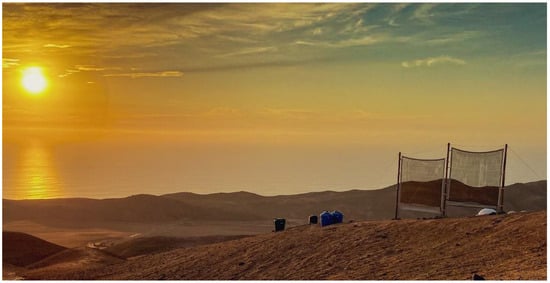
Figure 1.
Large fog collector installed at the Atacama UC Experimental Station, Alto Patache, coastal Atacama Desert.
The LFC technology mimics the local vegetation in capturing condensation as water from the windblown fog. It consists of a rigid frame that typically holds a 35% shade raschel mesh or similar. This form of water collection does not heavily impact the natural balance of the region and does not destabilize the local environment since the collection efficiency of LFCs is low [22]. Fog collectors are already in use worldwide, with examples in more than 40 countries globally [23]. The annual average water collection varies depending on several factors, including the location and altitude where the fog collectors are placed and the materials used in their construction [24]. Values reported in the literature range from 1 to 50 L per m2 of collector per day [24], while in the Atacama Desert, average daily values are between 0.9 and 8.2 L m−2 (Table 1). However, seasonal variability in water yield is expected due to changes in the sea surface temperatures and the displacement of the southeast Pacific anticyclone with its consequent shifts in air subsidence [25].

Table 1.
Daily average water collection from fog in various locations across the Atacama Desert.
1.2. Greenhouse Soilless Cultivation as a Low-Water Demanding Alternative
Greenhouses are stable structures used for protected cultivation, providing the advantage of reduced water consumption in arid environments, in comparison to open field cultivation [28]. Inside greenhouses, crops are commonly established in soilless systems, which further reduces water needs. For example, water requirements in lettuce crops is reduced from 40 L per plant in open field cultivation to only 2 L in hydroponic cultivation systems, considering a plant density of 25 plants m−2 [29]. These considerable water savings are explained by a smaller root volume and a larger plant density than in open field crops.
One of the disadvantages of hydroponic systems is the higher consumption of energy than open field crops, because of the continuous use of water/air pumps. However, the Atacama Desert presents the world’s largest potential for electricity production using photovoltaic panels [30]. Therefore, the production of soilless crops under greenhouse structures in the Atacama Desert would not require access to power grids.
The purpose of the present article is to evaluate the feasibility of horticultural production in the Atacama Desert based on greenhouse cultivation and fog water collection. The major objectives of the study include: (1) the analysis of seasonal variability of fog water collection in two locations in the Atacama Desert; (2) modeling the environmental parameters inside greenhouse structures; (3) estimating the energy demand for environmental conditions, along with energy production from photovoltaic panels; and (4) estimating the water requirement of a model hydroponic crop (lettuce) inside greenhouses for both locations.
2. Materials and Methods
2.1. Site of Study
The study was conducted at two locations in northern Chile: Alto Patache (20°49′ S/70°09′ W) and Falda Verde (26°17′ S/70°37′ W) (Figure 2). Alto Patache is a fog oasis located approximately 4 km from the coastline, on the coastal cliff, with an average altitude of 780 m.a.s.l. It is located in a mountain range with a NW to SE disposition, which exposes it to prevailing winds from the S and SW. Falda Verde is located approximately 700 km to the south of Alto Patache, in a similar position but at a lower altitude (600 m.a.s.l.). The distance from the coast is approximately 2 km and it is oriented perpendicularly to the prevailing S–SW winds.

Figure 2.
(A) Study site locations in the coastal Atacama Desert indicated with red dots (standard fog collector). Blue dots indicate the closest urban areas to the study sites. Standard fog collectors along with weather stations in Alto Patache (B) and Falda Verde (C).
2.2. Potential for Fog Water Collection
The amount of water collected was determined for each location following the methodology proposed by Schemenauer and Cereceda [31]. For this, a standard fog collector (SFC) (Figure 2B,C), consisting of a 1 × 1 m double 35% shade raschel mesh was used. The collector was installed two meters above the ground and positioned perpendicularly to the prevailing wind direction, with a 90° angle of inclination in relation to the ground. The SFCs collected the water droplets condensed in the air, channeling collected water to a recording and storage system consisting of a rain gauge and a drum coupled to a data logger. The SFCs quantified the amount of collected water, and the data are presented as daily yield in L per m2 of mesh per day in both study locations. The data series available for Alto Patache runs from December 2017 to the present. In Falda Verde, the data used has been collected since October 2021 to the present but in a different location, identified as Las Lomitas (Figure 2).
2.3. Simulation of Environmental Parameters under Greenhouse Conditions
In both locations, the environmental conditions under greenhouse structures were modeled based on computer simulations run to estimate the number of hours throughout the year in which crops will be exposed to optimal conditions. For this, an air temperature between 10 and 28 °C was considered as adequate. First, a database with information on incident solar radiation, air temperature and air relative humidity was downloaded from Meteonorm 8.0 for both locations. This information was used to simulate the environmental conditions within greenhouses considering no air renewals (greenhouse completely closed). Then, the energy requirement for ventilation was estimated, considering four levels of air exchange between the inside and the outside of the greenhouse (greenhouse with open vents): 10, 20, 40, and 60 air renewals per hour. An air renewal is considered a complete replacement of the air volume inside the greenhouse with outside air. The simulations were carried out using the calculation engine Energy Plus 8.9.0 loaded in the software Design Builder. All calculations were performed for a plastic greenhouse covering 100 m2 of soil surface. The total volume of the greenhouse used for the calculations was 250 m3. The covering material used for the simulations is a single-layer low-density polyethylene with a thickness of 0.2 mm.
2.4. Greenhouse Electricity Supply
Greenhouse cultivation requires water pumps for moving water from the collectors into storage tanks and air pumps for aeration of the nutrient solution supplied to the crops. Based on our previous experience, a hydroponic crop established in a 100 m2 greenhouse requires five 65 W air pumps running continuously 24 h a day and at least one 0.5 HP water pump with 400 W of power providing irrigation pulses of 2 min at 30 min intervals.
Considering the amount of solar radiation available in the Atacama Desert [30], a computational simulation was run to find the dimensions of a photovoltaic (PV) system capable of providing the greenhouse energy demand. The simulation was run using the dynamic simulation software Openmodelica [32], integrating within the model a PV field, inverter, battery storage, control, and greenhouse demand (Figure 3).
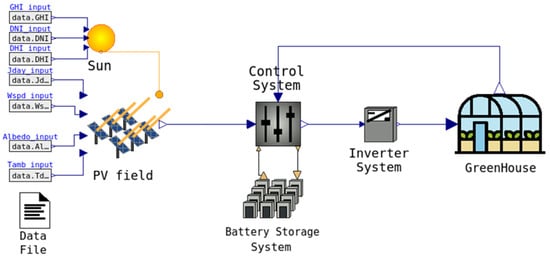
Figure 3.
The system-level approach used in the computational simulations. First, solar radiation intensity data were collected from available databases, and then the size of the photovoltaic (PV) field was determined based on the energy requirement from the greenhouse equipment. The system is complemented with batteries for energy storage during the day and supply during the night and also an inverter system to supply energy as alternate current (AC).
Using typical meteorological datasets available in SolCast [33], the amount of solar radiation on the surface of the PV modules was calculated on an hourly basis, following the methodology proposed by Duffie et al. [34]. Next, the PV system was modeled utilizing the methodology proposed by Castillejo-Cuberos [35], providing the maximum AC power output of each inverter and the charge state of the battery system. The implemented logic control scheme corresponds to a continuous demand-following power controller, which allows the estimation of the charge/discharge power in the battery bank and the power delivered by the control system to the greenhouse.
2.5. Crop Water Requirements
Based on the environmental simulations, the water demand for a lettuce crop was determined using the simplified Penman–Monteith equation proposed by Baille et al. [36] as follows:
where T is the amount of water transpired by the crop (kg m−2 s−1); α is the leaf angle distribution (0.64 [37]); LAI corresponds to the leaf area index (m2 m−2; 19.6 [38]); G is the incident solar radiation (W m−2); VPD is the air vapor pressure deficit (kPa); λ is the water vaporization latent heat (2260 KJ kg−1); and a and b are model parameters. Solar radiation transmitted into the greenhouse was determined as 85% of the incident solar radiation, based on our previous experience. The equation was solved using the highest values for a and b proposed by Baille et al. [36], namely 0.67 and 0.0037, respectively. Crop density was established at 25 plants m−2.
T = [a(1 − exp(−α·LAI)) G + (b·LAI·VPD)] λ−1
3. Results
3.1. Water Collection
Water collection in Alto Patache ranges from 0.41 ± 0.24 to 6.18 ± 1.96 L m−2 d−1 during February and July, respectively (Figure 4a), with an annual average value of 2.94 ± 1.16 L m−2 d−1. The lowest water collection value in Falda Verde was 1.27 ± 0.09 L m−2 d−1 in February and the highest value was found in November, at 7.42 ± 0.79 L m−2 d−1 (Figure 4b). The annual average for Falda Verde was 3.29 ± 0.73 L m−2 d−1.
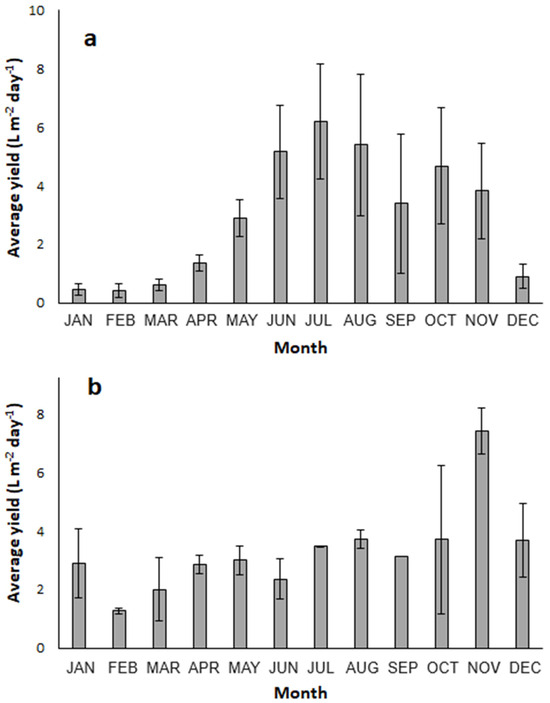
Figure 4.
Average ± s.e. daily water yield in L m−2 d−1 collected in Alto Patache (a) and Falda Verde (b) for each month of the year.
3.2. Environmental Parameters under Greenhouse Structure
Both locations present a mild climate throughout the year, with air temperatures ranging from 10.3 to 21.9 °C in Alto Patache and 12.4 to 23.2 °C in Falda Verde. Similarly, the range of air relative humidity is slightly higher in Falda Verde, ranging from 59.9 to 87.4%, than in Alto Patache (51.1 to 82.9%). Incident solar radiation shows a trend similar to that of the air temperature, with the highest values available between October and March for both locations. Under these conditions, the air temperature within the greenhouse would always be above 10 °C in both locations. Therefore, no heating requirements exist for crops. On the other hand, in 36.8% of the hours during the year, the air temperature would exceed 28 °C, reaching values over 40 °C in both locations if the greenhouse remains closed (Figure 5).
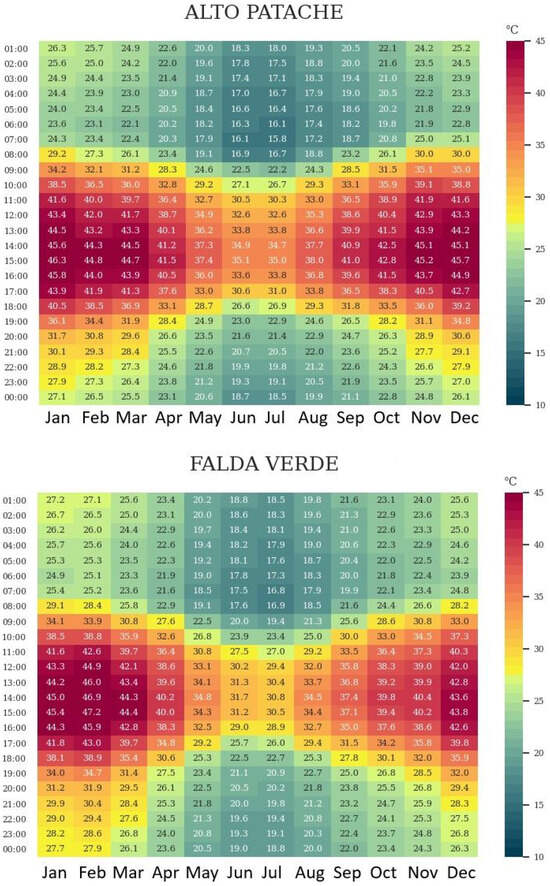
Figure 5.
Air temperature (°C) simulations inside a plastic greenhouse in Alto Patache (above) and Falda Verde (below). Each box represents the average monthly air temperature for every hour of the day.
Considering a totally closed greenhouse, an energy supply of 3600 kWh is required for mechanical ventilation in Alto Patache during December and January, while almost 3400 kWh is required in Falda Verde during January (Figure 6). In both locations, the simulations indicate that with 41 air renewals per hour, no energy will be required for active ventilation (Figure 6).
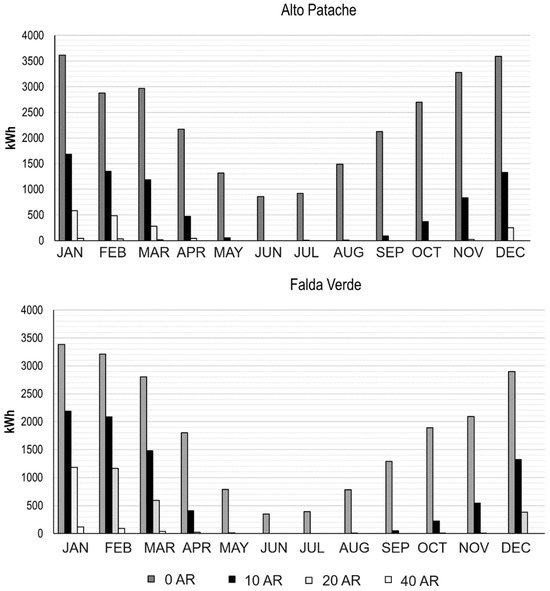
Figure 6.
Monthly energy requirement for ventilation in a greenhouse located in Alto Patache (above) and Falda Verde (below). Bars represent total energy requirement expressed in kWh for a greenhouse with no air renewals (0 AR) and with 10 (10 AR), 20 (20 AR), or 40 (40 AR) air renewals per hour.
3.3. Photovoltaic System
Total energy demand for the greenhouse was estimated at 9.4 kWh. Therefore, the storage capacity in the batteries needs to supply a similar amount of energy throughout the year. For both locations studied, this energy requirement can be supplied by a PV system composed of eight modules (total of 12.72 m2) and one inverter. This number of modules provides 2160 W (DC) and the inverter supplies 1821 W (AC) to the batteries. The simulated system can cover 100% of the energy requirement in Alto Patache for 69% of the hours during the year, and, in Falda Verde, 63% of the hours are covered (Figure 7). To fully cover 100% of the demand every day of the year, the PV system capacity must be doubled to 5400 W (DC) along with an extended storage capacity in the batteries to cover 18.8 kWh.
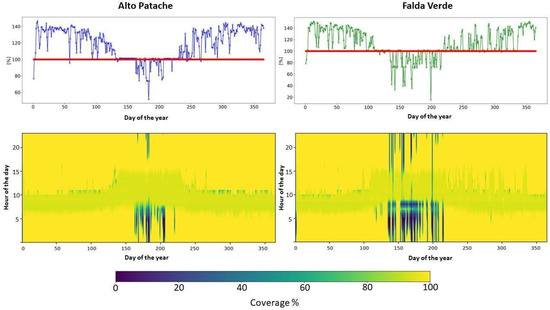
Figure 7.
Energy available in relation to the 9.4 kWh required (above) and hourly distribution along the year (below) for Alto Patache and Falda Verde.
3.4. Crop Evapotranspiration
In Alto Patache, daily evapotranspiration in a lettuce crop varies between 0.149 L m−2 d−1 in June and 0.874 L m−2 d−1 in December (Figure 8). A slightly lower water requirement was found in Falda Verde than in Alto Patache, with a minimum of 0.124 L m−2 d−1 in August and maximum evapotranspiration rate of 0.755 L m−2 d−1 in December (Figure 8). In both locations, the highest crop evapotranspiration demand takes place between October and March.
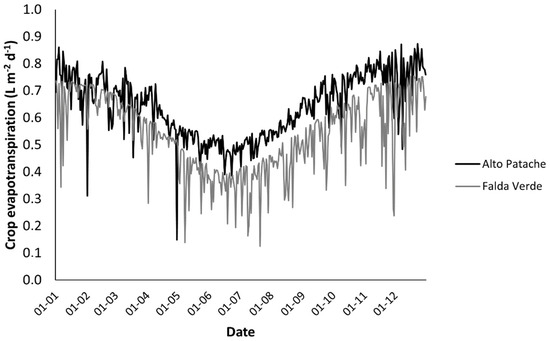
Figure 8.
Crop evapotranspiration throughout the year. Values represent the daily water loss (L m−2) according to the simplified Penman–Monteith model [31].
4. Discussion
4.1. Water Supply and Water Demand
Differences in water collection yield exist between both locations, with a steadier behavior throughout the year in Falda Verde than in Alto Patache. Falda Verde is located at a latitude regularly under the influence of the Southeast Pacific anticyclone, along with lower sea temperatures than in Alto Patache. Both conditions lead to a strong thermal inversion layer favoring the formation of fog [25]. On the other hand, Alto Patache has a period in which extremely low or null presence of fog occurs due to the southbound migration of the anticyclone. These conditions lead to the reduction of air subsidence, which, along with higher sea surface temperatures, produces a weak and high-altitude thermal inversion layer [25]. This condition forces a high interaction between the marine boundary layer and the dry air layer immediately above, inhibiting the formation of the cloud. Other differences between both fog collection locations include the distance to the coastline, where Alto Patache is approximately 4 km inland while Falda Verde is only 2 km, and the altitude, since Alto Patache is at 780 m.a.s.l. but Falda Verde is at 600 m.a.s.l. Both sites are located in mountain ranges with a NW to SE disposition exposed to prevailing winds from the S and SW.
The potential for effective water collection is significant, considering that the lowest yield in our results was 0.41 L per m2 of mesh per day in Alto Patache during February (Figure 4). Total water collection increases linearly with the extension of the fog collector. For example, the highest water requirement for evapotranspiration in Alto Patache is 0.874 L per m2 of ground per day. Therefore, to satisfy the demand during summer season, a collector surface of 2.13 m2 is required per m2 of ground covered with crops inside the greenhouse (213 m2 for a 100 m2 greenhouse, which equals approximately seven LFC). Considering that the highest water collection yield is available during winter and the highest water demand for evapotranspiration occurs in summer, it is possible to couple water collection with storage strategies to reduce the surface of fog collectors to be installed. Additionally, the materials used in the construction of LFCs only capture around 20% of the fog passing through [22]. It has been reported that this efficiency can increase by up to 300% by incorporating multiple length scales and hydrophobic materials in the mesh area [39]. By implementing these changes in materials and strategy, it is possible to obtain higher yields in water collection in the Atacama Desert than those reported in the present article.
An analysis conducted in California that studied the feasibility of supplying fresh water to large urban areas with fog collectors indicated that the amount of water was insufficient [40]. Similarly, irrigation of crops established in open fields demands a large, consistent water supply [41]. By comparison, irrigating greenhouse crops using water sourced from fog collectors proves to be much more viable due to the significantly reduced water requirements. This reduction in water requirements is explained by the small root volume and the modification in the environmental parameters (solar radiation, wind speed), in comparison to open field crops [29].
Fog is an underexploited water resource, available throughout the Pacific coast and not limited to the Atacama Desert area. Reports of fog collection exist for countries like Peru, Ecuador, and Guatemala in South America; Spain (Canary Islands) and Croatia in Europe; Namibia, Morocco, and South Africa in Africa; and Jordan, Yemen, Oman, and Saudi Arabia in Asia. Our results are in the range of those reported for the previously-mentioned countries [19,24], positioning fog as a global water resource that needs further attention.
4.2. Greenhouse Environmental Conditioning and Energy Demand
The air temperature within the greenhouses can easily exceed 28 °C due to the incident solar radiation. However, since the locations evaluated are coastal, the outside air temperature is favorable year-round, which implies that natural ventilation is enough to maintain adequate conditions for crop growth. Our calculations indicate that 41 air changes per hour are enough for maintaining the air temperature below 28 °C, in agreement with the recommendations by the American School of Agricultural Engineers, who suggest an air change rate between 40 and 60 changes per hour [42]. The advantages of air changes in greenhouse environments not only relate to temperature maintenance but also in helping to keep air humidity low, avoiding fungal diseases in the leaves, and limiting ambient CO2 depletion, which is consumed by the crops. Other equipment commonly found in greenhouses for environmental conditioning includes heating and cooling systems (HVAC) or supplemental lighting. As shown in Section 3.2, no heating requirements exist in either location, since the outside air temperature is always above 10 °C, making the environment comfortable for the majority of vegetable crops [43].
Artificial lighting has been shown to increase crop productivity in greenhouses due to the extension of the photoperiod, i.e., the number of daylight hours that allow plants to perform photosynthesis. Artificial lighting is also recommended for those crops established in high latitudes, where the intensity of solar radiation is low [44]. However, this is not the case for the area studied, as the intensity of solar radiation is among the highest in the world [30]. The lamps used for artificial (also known as supplemental) lighting are expensive, and thus they are most commonly found in large greenhouse facilities, which justify the cost. From the standpoint of food security in Latin America, which is not limited to the Atacama Desert, the priority overall is to increase local access to fresh and healthy food. Following this, ongoing investments in equipment for achieving high yields can be considered [9].
In the present article, we propose a low-cost greenhouse for vegetable production. A light wooden structure covered with plastic films (polyethylene in our analysis) provides an adequate greenhouse suitable for crop production in the coastal areas of the Atacama Desert. The structure also helps in reducing pest incidence on the crops, limiting the use of expensive pesticides. Within the greenhouse, vegetable crops can be established directly on the soil, or they can be grown using hydroponic (soilless) techniques. Soil salinity in the Atacama Desert is frequently high, with electrical conductivity values easily exceeding 10 dS m−1 [11]. Vegetable crops are considered to be sensitive to soil salinity, implying that they thrive well in soils with electrical conductivity values below 4 dS m−1 [45]. To cope with high soil salinity, soil amendments that include washing out the salts from the soil profile are commonly used [46]. However, this practice is not feasible in areas with low water availability like the Atacama Desert. Therefore, hydroponic systems are a more favorable alternative to direct soil cultivation. In the present article, we propose the use of deep flow systems, consisting of a 20 cm deep pool that holds a nutrient solution. Floating on top of the nutrient solution, plants are placed using materials like polystyrene [47]. The advantage of this type of hydroponic system is that it minimizes energy requirements, since the nutrient solution only needs continuous aeration, which is easily achieved with low-consumption air pumps. Other hydroponic systems, like the nutrient film technique (NFT) or aeroponic systems, present a higher energy demand than the floating system, since they rely on water pumps for continuous 24 h water pumping in a recirculating system [47], which implies a larger energy consumption than air pumps.
For our greenhouse and hydroponic system, energy requirements are fully met during the summer and spring seasons. However, in autumn and winter, the load in the batteries reduces because of a decrease in the number of hours with direct sun during the day. Since energy is required for water and air pumps activation, this energy demand must be adjusted for autumn and winter. Water pumps replace water as the crop consumes it for evapotranspiration, while air pumps inject air (oxygen) into the nutrient solution to sustain root respiration. Both processes, namely crop evapotranspiration and root respiration, depend upon the environmental temperature and solar radiation, which also decreases in winter in comparison to summer. Notably, the natural formation of the mountain ranges found in the coastal areas of the Atacama Desert allows for the collection and storage of water at the top of the hills. In turn, placing the greenhouses at a lower altitude than the storage tanks will enable gravity-fed water movement, eliminating the need for water pumps. Therefore, there is no need to increase the PV field size or the battery capacity since crop evapotranspiration is expected to decrease by up to 75% in winter in comparison to summer [48], while hourly root respiration is reduced by 5 to 10% for every 1° C reduction in air temperature [49].
5. Conclusions
The coastal areas in the Atacama Desert offer all of the required resources for sustainable crop production under greenhouse structures: water, energy, and excellent weather conditions during the whole year. Water is available in large quantities from fog, with the lowest values during the summer season and the highest during winter. Given the variance in water quantities collected between seasons, it is necessary to conduct further research to develop more efficient fog collection technologies and to design water storage strategies to ensure ample supply throughout the year. Environmental conditioning of greenhouses makes it possible to maximize yields thanks to the availability of solar energy that can be used for electricity generation based on photovoltaic systems. Combining greenhouse vegetable cultivation with hydroponic (soilless) techniques offers a highly viable alternative for securing a fresh food supply to the population in the area of study.
Further research is required to understand the yield potential for different horticultural crops and how they adapt to greenhouse conditions along the Atacama Desert.
Author Contributions
Conceptualization, F.A.; methodology, F.A., V.C., C.d.R., R.E. and L.V.; writing—original draft preparation, F.A.; writing—review and editing, C.d.R., V.C., R.E. and L.V. All authors have read and agreed to the published version of the manuscript.
Funding
This research and the APC were funded by ANID-Chile, grant number FONDECYT 13220028.
Institutional Review Board Statement
The study was conducted in accordance with the Declaration of Helsinki, and approved by the Ethics Committee of Pontificia Universidad Católica de Chile, protocol code 220805009 approved on 15 March 2023.
Informed Consent Statement
Not applicable.
Data Availability Statement
The data presented in this study are available upon request from the corresponding author.
Acknowledgments
The authors acknowledge the contribution of Ignacio Arias to the modeling of PV systems.
Conflicts of Interest
The authors declare no conflict of interest.
References
- Schulz, N.; Boisier, J.P.; Aceituno, P. Climate change along the arid coast of northern Chile. J. Clim. 2011, 32, 1803–1814. [Google Scholar] [CrossRef]
- Climatología: Informe de Precipitaciones. Available online: http://www.meteochile.gob.cl/inf_precipitacion.php (accessed on 18 April 2023).
- Oyarzún, J.; Oyarzún, R. Sustainable development threats, inter-sector conflicts and environmental policy requirements in the arid, mining rich, northern Chile territory. Sustain. Dev. 2011, 19, 263–274. [Google Scholar] [CrossRef]
- Scheihing, K. Water Resources Management in the Atacama Desert: Pivotal Insights into Arid Andean Groundwater Systems. Ph.D. Thesis, Technische Universität Berlin, Berlin, Germany, 2018. [Google Scholar]
- Pérez, F. Estimación de la Demanda actual, Proyecciones Futuras y Caracterización de la Calidad de los Recursos Hídricos en Chile; Ministerio de Obras Públicas: Santiago, Chile, 2017; 249p.
- Rojas, R.; Dassargues, A. Groundwater flow modeling of the regional aquifer of the Pampa del Tamarugal, northern Chile. Hydrogeol. J. 2007, 15, 537–551. [Google Scholar] [CrossRef]
- Síntesis de Resultados Censo 2017. Available online: https://www.ine.cl/docs/default-source/censo-de-poblacion-y-vivienda/publicaciones-y-anuarios/2017/publicaci%C3%B3n-de-resultados/sintesis-de-resultados-censo2017.pdf?sfvrsn=1b2dfb06_6 (accessed on 8 August 2022).
- Cambios Estructurales en la Agricultura Chilena. Análisis Intercensal 1976–1997–2007. Available online: https://www.ine.cl/docs/default-source/censo-agropecuario/publicaciones-y-anuarios/2007/cambios-estructurales-en-la-agricultura-chilena---analisis-intercensal-1976-1997-2007.pdf?sfvrsn=9dfd0a74_7 (accessed on 8 August 2022).
- Mahlknecht, J.; González-Bravo, R.; Loge, F.J. Water-energy-food security: A nexus perspective of the current situation in Latin America and the Caribbean. Energy 2020, 194, 116824. [Google Scholar] [CrossRef]
- Herrera-Calderon, O.; Yuli-Posadas, R.A.; Peña-Rojas, G.; Andía-Ayme, V.; Hañari-Quispe, R.D.; Gregorio-Chaviano, O. A bibliometric analysis of the scientific production related to “zero hunger” as a sustainable development goal: Trends of the pacific alliance towards 2030. Agr. Food Secur. 2021, 10, 34. [Google Scholar] [CrossRef]
- Casanova, M.; Salazar, O.; Seguel, O.; Luzio, W. The Soils of Chile; Springer: London, UK, 2013; pp. 27–55. [Google Scholar]
- Bonachela, S.; González, A.M.; Fernández, M.D. Irrigation scheduling of plastic greenhouse vegetable crops based on historical weather data. Irrig. Sci. 2006, 25, 53–62. [Google Scholar] [CrossRef]
- Sonneveld, C.; Voogt, W. Plant Nutrition of Greenhouse Crops; Springer: Amsterdam, The Netherlands, 2009; pp. 103–123. [Google Scholar]
- Salazar, O.; Chinchilla-Soto, C.; de los Santos-Villalobos, S.; Ayala, M.; Benavides, L.; Berriel, V.; Cardoso, R.; Chavarrí, E.; dos Anjos, R.M.; González, A.L.; et al. Water consumption by agriculture in Latin America and the Caribbean: Impact of climate change and application of nuclear and isotopic techniques. Int. J. Agric. Nat. Resour. 2022, 49, 1–21. [Google Scholar] [CrossRef]
- del Río, C.; Lobos, F.; Siegmund, A.; Tejos, C.; Osses, P.; Huaman, Z.; Meneses, J.P.; García, J.L. GOFOS, Ground Optical Fog Observation System for monitoring the vertical stratocumulus-fog cloud distribution in the coast of the Atacama Desert, Chile. In Proceedings of the 8th International Conference on Fog, Fog Collection and Dew, Taipei, Taiwan, 14–19 July 2019. [Google Scholar]
- Pliscoff, P.; Zanetta, N.; Hepp, J.; Machuca, J. Efectos sobre la flora y vegetación del evento de precipitación extremo de agosto 2015 en Alto Patache, Desierto de Atacama, Chile. Rev. Geogr. Norte Gd. 2017, 68, 91–103. [Google Scholar] [CrossRef]
- Cereceda, P. Los atrapanieblas: Tecnología alternativa para el desarrollo rural sustentable. Ambiente Desarro. 2000, 16, 51–56. [Google Scholar]
- Cereceda, P.; Larraín, H.; Osses, P.; Farías, M.; Egaña, I. The spatial and temporal variability of fog and its relation to fog oases in the Atacama Desert, Chile. J. Atmos. Res. 2008, 87, 312–323. [Google Scholar] [CrossRef]
- Klemm, O.; Schemenauer, R.S.; Lummerich, A.; Cereceda, P.; Marzol, V.; Corell, D.; Fessehaye, G.M. Fog as a fresh-water resource: Overview and perspectives. Ambio 2012, 41, 221–234. [Google Scholar] [CrossRef] [PubMed]
- del Río, C.; García, J.L.; Osses, P.; Zanetta, N.; Rivera, D.; Siegmund, A.; Wolf, N.; Cereceda, P.; Larraín, H.; Lobos, F. The ENSO control in coastal fog-water variability in the Atacama Desert, Chile. J. Aerosol Air Qual. Res. 2018, 18, 127–144. [Google Scholar] [CrossRef]
- Cheng, Y.; Zhang, S.; Liu, S.; Huang, J.; Zhang, Z.; Wang, X.; Yu, Z.; Li, S.; Chen, Z.; Zhao, Y.; et al. Fog catcher brushes with environmental friendly slippery alumina micro-needle structured surface for efficient fog-harvesting. J. Clean. Prod. 2021, 315, 127862. [Google Scholar] [CrossRef]
- Schemenauer, R.; Joe, P. The collection efficiency of a massive fog collector. Atmos. Res. 1989, 24, 53–69. [Google Scholar] [CrossRef]
- Yue, H.; Zeng, Q.; Huang, J.; Guo, Z.; Liu, W. Fog collection behavior of bionic surface and large fog collector: A review. Adv. Colloid. Interfac. 2020, 300, 102583. [Google Scholar] [CrossRef]
- Azeem, M.; Noman, M.T.; Wiener, J.; Petru, M.; Louda, P. Structural design of efficient fog collectors: A review. Environ. Technol. Innov. 2020, 20, 101169. [Google Scholar] [CrossRef]
- del Río, C.; Lobos-Roco, F.; Latorre, C. Spatial distribution and interannual variability of coastal fog and low clouds cover in the hyperarid Atacama Desert and implications for past and present Tillandsia landbeckii ecosystems. Plant Syst. Evol. 2021, 307, 58. [Google Scholar] [CrossRef]
- Larraín, H.; Velásquez, F.; Espejo, S.; Pinto, R.; Cereceda, P.; Osses, P. Fog measurements at the site “Falda Verde” North of Chañaral (Chile compared with other North Chilean fog stations). J. Atmos. Res. 2002, 64, 273–284. [Google Scholar] [CrossRef]
- Stanghellini, C.; Ooster, B.; Heuvelink, E. Greenhouse Horticulture: Technology for Optimal Crop Production; Wageningen Academic Publishers: Wageningen, The Netherlands, 2019; pp. 14–24. [Google Scholar]
- Carvajal, D.; Mora-Carreño, M.; Sandoval, C.; Espinoza, S. Assessing fog water collection in the coastal mountain range of Antofagasta, Chile. J. Arid Environ. 2022, 198, 104679. [Google Scholar] [CrossRef]
- El-Nakhel, C.; Giordano, M.; Pannico, A.; Carillo, P.; Fusco, G.M.; De Pascale, S.; Rouphael, Y. Cultivar-specific performance and qualitative descriptors for butterhead Salanova lettuce produced in closed soilless cultivation as a candidate salad crop for human life support in space. Life 2019, 9, 61. [Google Scholar] [CrossRef]
- Pravalie, R.; Patriche, C.; Bandoc, G. Spatial assessment of solar energy potential at global scale. A geographical approach. J. Clean. Prod. 2019, 209, 692–721. [Google Scholar] [CrossRef]
- Schemenauer, R.S.; Cereceda, P. A proposed standard fog collector for use in high-elevation regions. J. Appl. Meteorol. 1994, 33, 1313–1322. [Google Scholar] [CrossRef]
- Scott, P.; Alonso, A.; Hinkley, J.; Pye, J. SolarTherm: A flexible Modelica-based simulator for CSP systems. In Proceedings of the AIP Conference, Abu Dhabi, United Arab Emirates, 11–14 October 2016. [Google Scholar]
- Bright, J.M. Solcast: Validation of a satellite-derived solar irradiance dataset. Sol. Energy 2019, 189, 435–449. [Google Scholar] [CrossRef]
- Duffie, J.A.; Beckman, W.A. Solar Engineering of Thermal Processes; John Wiley and Sons: Hoboken, NJ, USA, 2013; pp. 236–321. [Google Scholar]
- Castillejo-Cuberos, A.; Cardemil, J.M.; Escobar, R. Techno-economic assessment of photovoltaic plants considering high temporal resolution and non-linear dynamics of battery storage. Appl. Energy 2023, 334, 120712. [Google Scholar] [CrossRef]
- Baille, M.; Baille, A.; Laury, J.C. A simplified model for predicting evapotranspiration rate of nine ornamental species vs. climate factors and leaf area. Sci. Hortic. 1994, 59, 217–232. [Google Scholar] [CrossRef]
- Stanghellini, C. Transpiration of Greenhouse Crops: An Aid to Climate Management. Ph.D. Thesis, Wageningen University and Research, Wageningen, The Netherlands, 1987. [Google Scholar]
- Djidonou, D.; Leskovar, D.I. Seasonal changes in growth, nitrogen nutrition, and yield of hydroponic lettuce. HortScience 2019, 54, 76–85. [Google Scholar] [CrossRef]
- Gürsoy, M.; Harris, M.T.; Downing, J.O.; Barrientos-Palomo, S.N.; Carletto, A.; Yaprak, A.E.; Karaman, M.; Badyal, J.P.S. Bioinspired fog capture and channel mechanism based on the arid climate plant Salsola crassa. Colloid Surface A 2017, 529, 195–202. [Google Scholar] [CrossRef]
- Domen, J.K.; Stringfellow, W.T.; Camarillo, M.K.; Gulati, S. Fog water as an alternative and sustainable water resource. Clean Technol. Environ. Pol. 2014, 16, 235–249. [Google Scholar] [CrossRef]
- Rosa, L.; Chiarelli, D.D.; Tu, C.; Rulli, M.C.; D’Odorico, P. Global unsustainable virtual wáter flows in agricultural trade. Environ. Res. Lett. 2019, 14, 114001. [Google Scholar] [CrossRef]
- Muñoz, P.; Montero, J.I.; Antón, A.; Giuffrida, F. Effect of insect-proof screens and roof openings on greenhouse ventilation. J. Agric. Engng. Res. 1993, 73, 171–178. [Google Scholar] [CrossRef]
- Krug, H. Environmental influence on development, growth and yield. In The Physiology of Vegetable Crops; Wien, H.C., Ed.; CABI Publishing: Oxon, UK, 1999; pp. 101–180. [Google Scholar]
- Paradiso, R.; Proietti, S. Light-quality manipulation to control plant growth and photomorphogenesis in greenhouse horticulture: The state of the art and the opportunities of modern systems. J. Plant Regul. 2022, 41, 742–780. [Google Scholar] [CrossRef]
- Shannon, M.C.; Grieve, C.M. Tolerance of vegetable crops to salinity. Sci. Hortic. 1998, 78, 5–38. [Google Scholar] [CrossRef]
- Zhang, Y.F.; Li, Y.P.; Sun, J.; Huang, G.H. Optimizing water resources allocation and soil salinity control for supporting agricultural and environmental sustainable development in Central Asia. Sci. Total Environ. 2020, 704, 135281. [Google Scholar] [CrossRef] [PubMed]
- Son, J.E.; Kim, H.J.; Ahn, T.I. Hydroponic systems. In Plant Factory: An Indoor Vertical Farming System for Efficient Quality Food Production, 2nd ed.; Kozai, T., Niu, G., Takagaki, M., Eds.; Academic Press: London, UK, 2020; pp. 273–283. [Google Scholar]
- Medrano, E.; Lorenzo, P.; Sánchez-Guerrero, M.C.; Montero, J.I. Evaluation and modeling of greenhouse cucumber-crop transpiration under high and low radiation conditions. Sci. Hortic. 2005, 105, 163–175. [Google Scholar] [CrossRef]
- Morard, P.; Silvestre, J. Plant injury due to oxygen deficiency in the root environment of soilless culture: A review. Plant Soil 1996, 184, 243–254. [Google Scholar] [CrossRef]
Disclaimer/Publisher’s Note: The statements, opinions and data contained in all publications are solely those of the individual author(s) and contributor(s) and not of MDPI and/or the editor(s). MDPI and/or the editor(s) disclaim responsibility for any injury to people or property resulting from any ideas, methods, instructions or products referred to in the content. |
© 2023 by the authors. Licensee MDPI, Basel, Switzerland. This article is an open access article distributed under the terms and conditions of the Creative Commons Attribution (CC BY) license (https://creativecommons.org/licenses/by/4.0/).